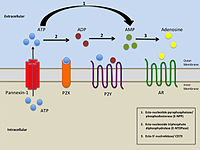
Photo from wikipedia
GPRC6A, an important member of the G-protein-coupled receptor superfamily, has been widely studied in body health maintenance and related diseases. However, it is still controversial whether GPRC6A plays a vital… Click to show full abstract
GPRC6A, an important member of the G-protein-coupled receptor superfamily, has been widely studied in body health maintenance and related diseases. However, it is still controversial whether GPRC6A plays a vital role in glucose homeostasis, and the role of GPRC6A on amino acid homeostasis has not been reported. In this study, GPRC6A was knocked out in C57BL6 mice, and we found that GPRC6A plays an important role in the glucose metabolism, mainly affecting the glucose clearance capacity and gluconeogenesis in mice. GPRC6A plays an important role in maintaining amino acid homeostasis under dietary restrictions, and this may be realized by participating in the regulation of autophagy. Since a large amount of amino acid is lost from urine in aged GPRC6A−/− mice, it is possible that GPRC6A regulates amino acid homeostasis by affecting the integrity of tissue structure. GPRC6A is involved in the regulation of mTORC1 activation but is not necessary for mTORC1 activation under sufficient nutritional supply. In the absence of exogenous amino acids, the loss of GPRC6A induces the GCN2 pathway activation and excessive autophagy of cells, leading to the overactivation of mTORC1, which may be detrimental to body health and cell survival. In summary, this study provides a theoretical and experimental basis for the metabolic process of GPRC6A in body growth and health.
Journal Title: Metabolites
Year Published: 2022
Link to full text (if available)
Share on Social Media: Sign Up to like & get
recommendations!